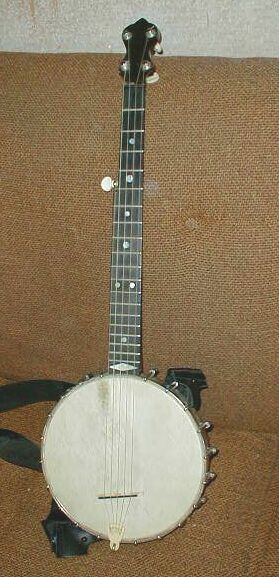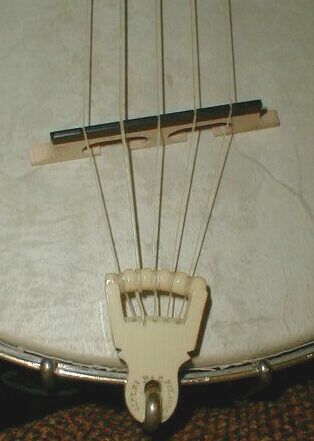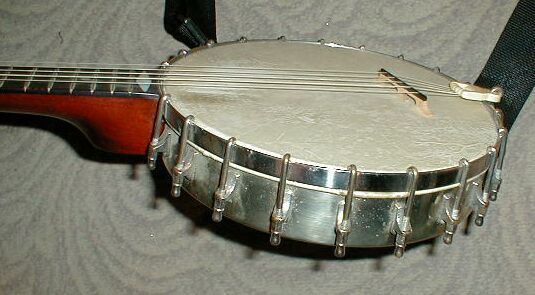

|
Here are some of photos of my Fairbanks & Cole banjo all strung up with its new gut strings. While this banjo is not a valuable antique, it is really fun to play and it sounds nice. According to the information on the net and the serial number on the banjo, it was made in 1890.
This banjo has a short scale of only 24 inches, so it is tuned to the key of A. It was in pretty bad shape when I bought it, so I had it restored to playability.
The tuning pegs are a modern addition, although they were on it when I bought it. The 5th string peg is new. Most of the MOP inlays are new. The skin head was on it when purchased. As far as I can tell, the tailpiece is original as are the brackets and hooks.
The fellow who restored the banjo put nylon strings on it at my request. But since I have found that I really like to play it, I have purchased a set of gut strings and strung it up as it was originally done.

|
The photo on the right is of the Fairbanks & Cole ivoroid tailpiece. On the underside of the tailpiece there are five circular indentations. Each indentation has a hole that comes out at the front of the main body of the tailpiece.
The string has a knot tied in the end of it. The knot sits in the indentation in the tailpiece. Then, it passes up through the hole in the main body of the tailpiece and down through the space between the main body and the bar across the top. It then loops around the bar once, back down through the space and out to the bridge. This wraps the string around the bar once. I wrapped it so that the string comes off the bottom of the bar to move the strings closer to the head as they go toward the bridge.

|
It is a bit difficult to see in the photo, so here is a second photo where you can see that the strings wrap around the bar in the slots provided. You cannot see where the strings are knotted because the knots are underneath the tailpiece.
Compared to the nylon strings, the gut strings seem very light and responsive. They take a very light touch to make them play. They are a bit more quiet than the nylon, but the note separation is very good.
All-in-all, I am pleased with the results of the gut strings.
The construction of the banjo is very
basic and simple.

|
The rim is full spun with bright metal. The hooks are round, and there are 20 of them around the hoop.

|
As we move closer in, it is a bit more evident how the hooks and tension hoop work.

|
You can see that the tension hoop is neither grooved nor nothched. Instead, it seems to be rabbeted. It is like a grooved hoop, but there is no inside wall. The hooks are flattened on the side which faces the head.
On the inside of the banjo we have slotted screws holding the shoes. This marks the banjo as a low end instrument since the more expensive instruments had hexagonal heads on the screws.

|
A basic shot of the inside. Look at the beautiful red color of the wood in this banjo. I think that it is mahogony. The fretboard is dyed black.
Here you can see the wavy Fairbanks & Cole logo stamped on the dowel stick, which identifies the banjo as having been made after the split between the two partners.

And the Trademark stamp.

The tail end of the dowel stick is just plain

|
and the head end, has a strange little screw holding the neck in place.

|

|
This page originally posted January 7, 2002